IT IS CHELSEA TIME AGAIN
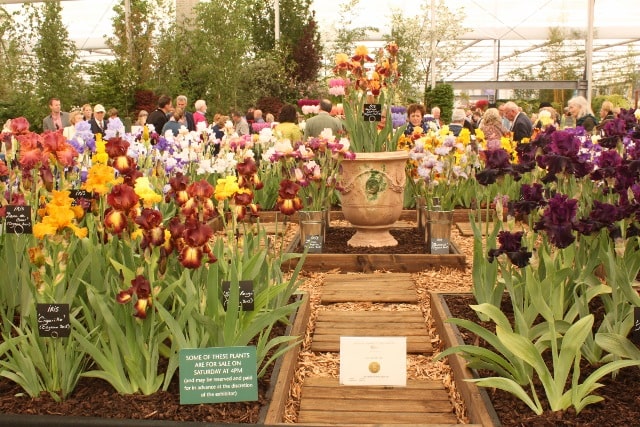
It’s Gold… Cayeux Iris stand 2015 grown and staged by Iris of Sissinghurst
Background to this blog
Sue Marshall is the owner of the nursery Iris of Sissinghurst. The nursery started in the back garden of a house close to the main entrance to Sissinghurst Castle Gardens in Sissinghurst over three decades ago. Sue and her then business partner both had a passion for plants and decided to launch the nursery as a specialist in growing varieties from the iris family. The nursery quickly developed a reputation for growing iris to a high standard and was invited to become involved in showing at the Chelsea Flower Show. This is a short blog written by Sue of some of her recollections of the Chelsea Flower Show
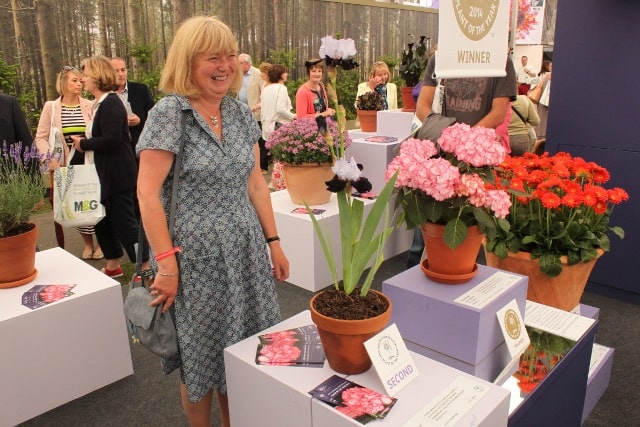
Sue Marshall with second placed Iris ‘Domino Noir‘ in the RHS Chelsea Plant of the Year 2014. The famous black and white iris bred by Richard Cayeux. Domino was the name of Sue’s cat!
My introduction
Chelsea is fast approaching and our preparation for a small display of Iris in the Great Pavilion is well underway. It is, of course, lovely to be back at Chelsea. My last involvement was in 2019. The show in 2020 was cancelled in March of that year as a result of the pandemic and this year, 2022, is the first to take place in the traditional late May schedule. I have been very fortunate to have been involved in growing iris for both garden designers and for the Great Pavilion throughout the 2000s. In the case of the Great Pavilion the nursery worked in partnership with Cayeux Iris, the largest iris nursery in Europe throughout this period growing the varieties, creating the displays and managing the stand during the week of the show.
It has been a rollercoaster with lots of ups and downs, with stress levels occasionally through the roof. I have attempted below to confide with you on some of these experiences. I like to call them the “pleasure and pain” of growing for the RHS Chelsea Flower Show.
The Show Begins

All loaded up and ready to go!
The Chelsea Show begins for me nine months before the opening of the Show. Firstly the application to be involved has to be submitted to the Royal Horticultural Society in late summer. In the case of the Great Pavilion you must decide what size and shape of stand you will require. In the case of the iris plants these need to be selected, dug up from the iris beds and planted in pots ready for growing under cover in advance of the following year’s show. Remember you are selecting plants in August which must be in flower and in perfect condition for the third week of May the following year. NO pressure then. All this takes place a couple of months BEFORE you are told if your application has been successful.
Apart from ensuring you choose the best plants you also need to second guess the likely colours which will be the most popular. The popularity, like fashion, does change from year to year. This year for example orange/peachy colours appear incredibly popular.
My involvement with Cayeux Iris started shortly after the nursery was formed. We learnt a great deal at the first Chelsea Show. The RHS awarded the display a silver gilt medal (second only to the coveted gold medal). Not bad for the first effort. I am however surprised we returned. Two things stand out about the first Show. We decided to display the iris in one of the tiered display stands. These are located against the ends of the pavilion and plants are placed in a stepped fashion. Whilst this means that the iris are clearly visible it is impossible to water all the plants during the show and to be able to “deadhead” those iris flowers that are passed their best during the show. The second lesson to be learnt was a very painful one. We decided, at the end of the final day of the Show, to leave the removal of the stand and plants until the following day. When we returned the following day the plants had been stolen, including rare varieties!!!!!
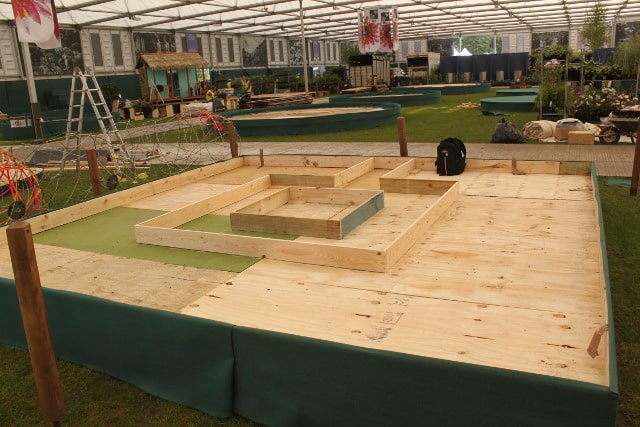
The built stand before the irises have arrived. How are we ever going to fill that space?
Lessons learnt
The nursery decided not to use tier displays at future shows and all pots are now numbered so if stolen the thief has only taken No.235 as opposed to a named variety. Much more tricky to sell a variety known as No 235!!! The next year Cayeux insisted on being involved in the design of the stand. This resulted in the erection of a pigeonnier as the focal point of the display. It was the tallest of anything else in the Great Pavilion and was used by people as a “location finder” for anyone that became lost. The display was however more traditional and much easier to manage during the week of the show. (A silver medal was awarded).
We decided by mutual agreement to have a break from Cayeux iris to concentrate on growing iris for garden designers on the show gardens. However Cayeux experienced difficulties with another well know specialist nursery. The plants did not flower in time for the Chelsea Show and indeed photographs appeared in the press showing attempts to bring the plants to flower with the use of hairdryers! It did not work. I am afraid no medal was awarded.
Cayeux Iris persuaded us to return as partners working at Chelsea the following year. This relationship has continued until the intervention of the pandemic in 2020. The intervening years created lots of memories and experiences both in the Pavilion and in the show gardens. The first year back saw the award of a silver gilt medal. Whilst this was very satisfying it was rounded off with the use of a Kent bred iris exclusive to the nursery for a large show garden. This generated a lot of interest, including that of the BBC.

The finished stand in 2015
Joe Swift asked to interview me as part of a programme about “growers behind the scenes”. Joe Swift has a rich sense of humour. I had not been filmed before so I was a total novice. I was told in no uncertain terms before leaving the nursery “don’t say anything stupid or look like a nincompoop!!!. Joe noticed that I looked after the plants for 9 months before Chelsea so was determined to get me to say that these were my babies. I was nearly caught out on several occasions but managed to get home without too much of a disaster. It was however nice to be able to represent those nurseries and professional people that create the plants that make visiting Chelsea so worthwhile.
The Practicalities of Growing for the Show
The nursery manages the over wintering of the iris under cover. This allows for control of watering and protects the plants from any extremes of the British winter. The plants have been planted in two or three litre pots using a special soil mixture (the contents of the mixture is a secret composition known only to the nursery). The condition of the plants is monitored daily. In early spring the watering regime starts to change depending on the outside temperatures and quality of light. It is necessary to prepare more plants than the final number used for the displays. This is because there will always been an element of uncertainty about the weather conditions and this dictates when the iris will be in flower. Iris CANNOT be held back or flowering brought forward without significant risk and I do not recommend that this is tried. Control of watering and the quality of light is perhaps the only methods that are used by the nursery.
The Building of the Display
I could write a book about the pre-Chelsea week work that has to take place. Some of the experiences could be used for comedy programmes, some for real life drama stories and some for tragedy/disaster movies. For this blog I will just reflect on the timing and tasks that take place.
The nursery will visit Chelsea on the Wednesday of the week before the opening. This is to inspect the site, discuss with RHS representatives access arrangements and to work out any problems that could arise. The nursery arrives at Chelsea the following day and builds the display stand. The plants are then delivered on site on Friday afternoon/evening. (I do not want to talk about the chaos of trying to get into the site and then trying to offload a few hundred delicate plants!!!). The work of creating the display then takes place throughout the weekend, finishing on the Sunday evening. The team leaves the site and await the judges’ decision about the medal to be awarded. It is announced on the Tuesday morning. This decision decides the mood I will be in on my way into the Show.
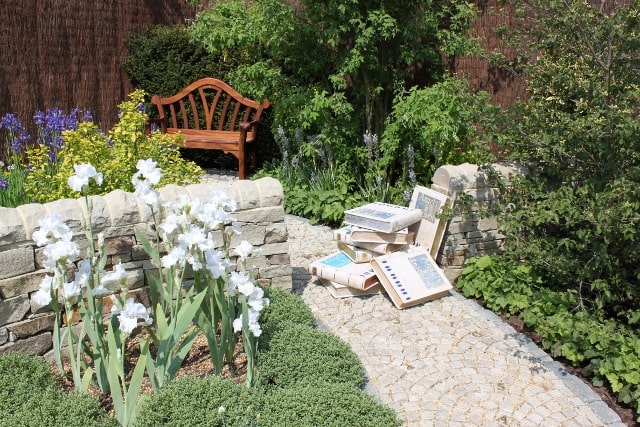
‘Dyslexia – A Barrier to Education?’ Garden designed by Tim Fowler for the Dyslexia Research Trust at RHS Chelsea 2010
Individual Show Gardens
In addition to business sponsored gardens a number of charities use the Chelsea Flower Show to highlight their role in society and to generate interest in the work they undertake. I have been fortunate to work with a number of these charities. Jo Thompson, a very talented garden designer, has been involved in a number of such gardens. This has included the Demelza House, a local hospice. Jo asked me if we would be able to premier a new iris for this garden. The iris was named after Maidstone and was called County Town Red, a beautiful rich red coloured iris. This was bred by Olga Wells. This was followed up by another charity garden by Jo Thompson for Thrive and again we were able to introduce another new variety, Jamie Roo, bred by Brian Hersey. Both breeders are nationally important Kent based growers.
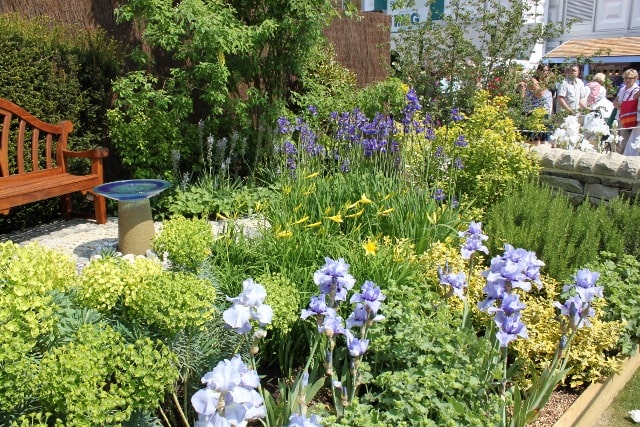
Another photo of the Dyslexia Garden RHS Chelsea 2010
Other charity gardens of a high design standard have included the Modern Slavery Garden, designed by Juliet Sargeant. Again a very talented garden designer with a real feel for plants and their setting. Finally I must mention the Dyslexia Garden designed by Tim Fowler. Tim came down from Yorkshire to Chelsea in a van on one of the hottest days of that year (I think it was 2010). When he arrived on site he found that many of his plants had “overheated” and did not look happy. I am pleased to report that other gardens offered some of their plants as replacements and the garden was finished without further mishap.
Teamwork is the key
There is no better feeling than to finish a display on the Sunday evening knowing that irrespective of the results of the judging everyone involved has worked to ensure that the display is the best that can be achieved. In the early years I was helped by Jo Mathieu and Carol Hersey. This was the team that achieved the first of our gold medals for Cayeux Iris in 2015. Both Carol and Jo are enthusiastic amateurs (but more importantly friends) but their knowledge of plants and gardening is exceptional.
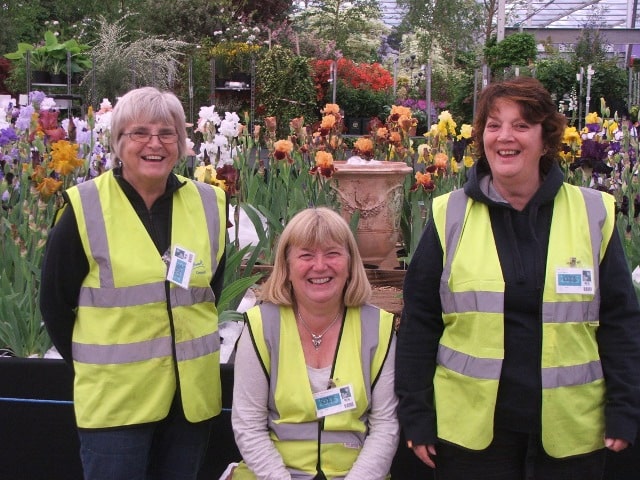
The first Gold Medal winning team.
I approached Andy Garland, BBC Kent Radio, after 2015, to see if he could help find a new generation of enthusiasts who could help with future Chelsea Shows. Andy, who has always been very supportive of Kent nurseries via Sunday Radio Garden programmes, agreed to help. He contacted a number of people who he thought could form a new “dream team”. The core team included Sophie (who still is a key person in the nursery), Steve Edney (THE Steve Edney) and Lou Dowle (the BOSS) as well Kate Blacker (famous for her peony nursery which is also in Kent). This team went on to further gold and silver medals.
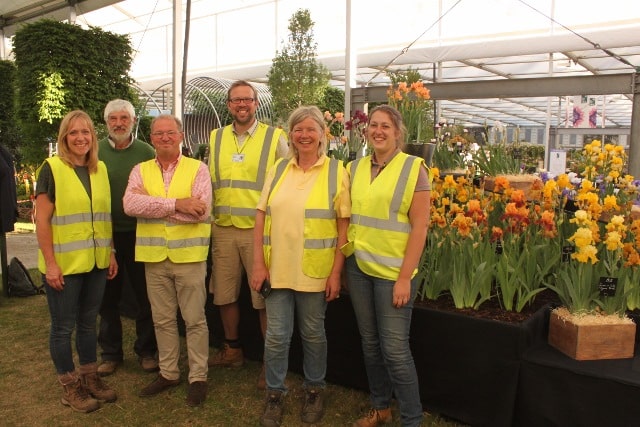
Dream team number 2 – Hazel Wright, Harry, Richard Cayeux, Steve Edney, Sophie and Lou Dowle.
In Summary
I hope that you have enjoyed this fast-forward commentary on my involvement with the Chelsea Show. I have been told that many people prefer brief items so I have had to be very disciplined about what to include or more importantly to exclude. I have therefore not included some of the stories about the building of the displays, the nightmares of trying to manage the presentation of new plants, the rivalries with other nurseries and lots more. Perhaps these will appear in a more detailed story in the future. Watch this space.
In summary, over the years, I think I can say Iris of Sissinghurst can be proud of our success at Chelsea. As to the future well who knows what the future holds????
We would like to thank all those people who have helped us stage the Chelsea exhibit including Tracey and Elaine Smith, Tom Leathart and Andy Garland’s fellow RHS students Steve Pollard, Tracey Tristem and Katie McCafferty.
